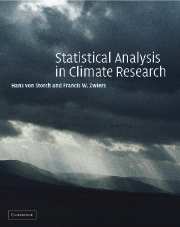Book contents
3 - Distributions of Climate Variables
Published online by Cambridge University Press: 03 February 2010
Summary
The Components of the Climate System.
The climate system is composed of all processes that directly or indirectly control the atmospheric environment of humans and ecosystems. The main components of the system are the hydro- and thermodynamic states of the atmosphere and the ocean. Sea ice affects the exchange of heat, momentum and fresh water between oceans and atmosphere. On longer time scales, the shelf ice and the land ice become relevant since these components are able to store and release large quantities of fresh water. The atmosphere, ocean, and land surface are interconnected by means of the hydrological cycle on a number of time scales. Precipitation falls on the land where it affects land surface properties such as albed and heat capacity. Some of this precipitation evaporates into the atmosphere, and some flows to the ocean as runoff. Fresh water flux into the ocean by means of precipitation and runoff, and out of the ocean through evaporation, affects ocean variability, which in turn feeds back on atmospheric variability.
Changes in the chemical composition of the atmosphere also impact the climate system because the concentration of carbon dioxide, ozone, or other radiatively active gases affects the radiative balance of the atmosphere. These concentrations are controlled by the state of the atmosphere and the ocean, as well as the biospheric and anthropogenic sinks and sources of these chemicals. Clearly the components of the climate system cannot be defined exhaustively, since it is not a closed system in a strict sense.
- Type
- Chapter
- Information
- Statistical Analysis in Climate Research , pp. 51 - 68Publisher: Cambridge University PressPrint publication year: 1999

